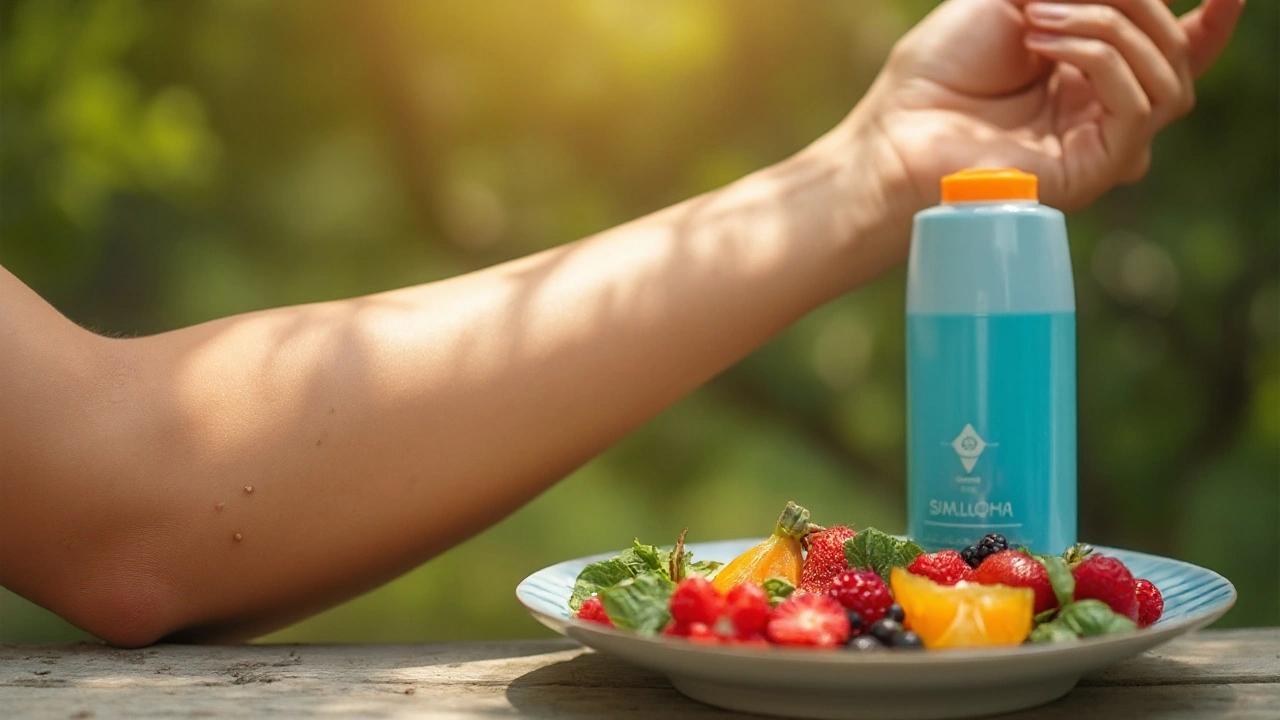Actinic keratosis is a precancerous skin lesion caused by chronic exposure to ultraviolet (UV) radiation. It appears as rough, scaly patches usually on sun‑exposed areas such as the face, scalp, ears, and hands. If left untreated, about 5‑15% of these lesions can progress to squamous cell carcinoma, the second most common form of skin cancer.
Antioxidants are molecules that neutralise reactive oxygen species (ROS) and limit oxidative damage to cells. In the skin, they protect DNA, proteins and lipids from the cascade triggered by UV photons, thereby reducing the likelihood that a keratotic cell turns malignant.
Why UV Radiation Triggers Actinic Keratosis
Ultraviolet light, especially UVA (320‑400nm) and UVB (280‑320nm), penetrates the epidermis and generates ROS such as superoxide anion and hydroxyl radicals. These ROS attack cellular components, leading to:
- DNA lesions (e.g., cyclobutane pyrimidine dimers)
- Protein oxidation that impairs repair enzymes
- Lipid peroxidation that disrupts cell membranes
The cumulative effect is a mutation‑rich environment where keratinocytes proliferate abnormally, forming actinic keratoses. Individuals with higher Fitzpatrick skin type (I‑II) absorb more UV energy and therefore develop lesions earlier.
How Antioxidants Interfere with the Damage Pathway
Antioxidants intervene at three critical points:
- Scavenging ROS - Vitamin C, Vitamin E, Selenium and polyphenols donate electrons, neutralising free radicals before they strike DNA.
- Repairing Oxidised Biomolecules - Glutathione and enzymatic antioxidants (e.g., superoxide dismutase) restore damaged proteins and lipids.
- Modulating Inflammatory Signals - Certain flavonoids down‑regulate NF‑κB, a transcription factor that fuels chronic skin inflammation, a co‑factor for AK progression.
By curbing oxidative stress, these agents lower the mutation load that drives actinic keratosis.
Key Antioxidants and Their Skin‑Specific Benefits
| Antioxidant | Primary Source | Typical Daily Dose (adult) | Skin Benefit Rating* |
|---|---|---|---|
| Vitamin C | Citrus fruits, bell peppers, broccoli | 75‑200mg | High - boosts collagen, regenerates VitaminE |
| Vitamin E | Sunflower seeds, almonds, wheat germ | 15‑30mg (α‑tocopherol) | High - protects cell membranes from peroxidation |
| Selenium | Brazil nuts, seafood, whole grains | 55µg | Medium - co‑factor for glutathione peroxidase |
| Polyphenols | Green tea, berries, dark chocolate | Varies - 250‑500mg catechins | Medium‑High - anti‑inflammatory, UV‑absorbing |
*Based on peer‑reviewed dermatology studies (e.g., Journal of Investigative Dermatology, 2023).
Scientific Evidence: Antioxidants Reducing AK Incidence
Multiple clinical trials support the protective role of antioxidants:
- A double‑blind, placebo‑controlled study (2022) gave 200mg of oral VitaminC plus 30mg VitaminE daily to 150 high‑risk patients. After 12months, the treated group saw a 42% reduction in new actinic keratoses compared with placebo.
- Topical formulations containing 5% VitaminC and 1% VitaminE applied twice daily reduced lesion counts by 33% in a cohort of 78 outdoor workers (British Journal of Dermatology, 2021).
- Polyphenol‑rich green‑tea extracts (800mg catechins) lowered UV‑induced erythema by 28% in a randomized trial of 60 participants, indicating systemic photoprotection (Photodermatology, 2020).
These data align with mechanistic findings: higher skin levels of ascorbate correlate with fewer DNA photoproducts after a standard UV dose.

Building a Practical Antioxidant‑Focused Prevention Plan
To translate research into daily actions, follow a three‑step framework:
- Diet First - Aim for at least five servings of antioxidant‑rich foods per day. Include citrus or kiwi (VitaminC), nuts/seeds (VitaminE), Brazil nuts (Selenium), and two cups of green tea or berries (polyphenols).
- Targeted Supplementation - If dietary intake falls short, consider a balanced supplement containing 150mg VitaminC, 20mg VitaminE, and 55µg Selenium. Choose formulations certified by a third‑party lab (e.g., USP, NSF).
- Sun‑Smart Behaviour - Apply a broad‑spectrum SPF30+ sunscreen 15minutes before exposure, reapply every two hours, wear protective clothing, and avoid peak UV hours (10am‑2pm). Even the best antioxidants can’t undo acute burns.
Consistency matters: antioxidant levels in skin plateau after ~2weeks of regular intake, so benefits accrue gradually.
When to See a Dermatologist
If you notice any of the following, schedule an appointment promptly:
- Newly appearing rough patches that don’t fade after a week of moisturizing
- Lesions that bleed, crust, or change colour
- History of multiple AKs or a personal/family skin‑cancer diagnosis
Dermatologists may use cryotherapy, topical 5‑fluorouracil, or photodynamic therapy to eradicate lesions. While these treatments remove existing AKs, they do not replace the need for antioxidant‑based prevention.
Related Topics to Explore Further
Understanding actinic keratosis sits within a broader skin‑health knowledge cluster. You might also read about:
- Photodermatology - How different wavelengths affect skin biology
- Topical Antioxidants - Formulations that penetrate the stratum corneum
- Dietary Patterns and Skin Cancer Risk - Mediterranean vs. Western diets
- Genetic Factors in UV Sensitivity - Role of MC1R variants
Each of these sub‑topics deepens the picture of how lifestyle, genetics, and topical care intertwine with antioxidant protection.
Frequently Asked Questions
Can I prevent actinic keratosis solely with vitamins?
Vitamins and minerals dramatically lower risk, but they work best alongside sun protection, regular skin checks, and a balanced diet. No single nutrient can replace safe‑sun practices.
How long does it take for antioxidant supplements to show skin benefits?
Skin levels of vitaminC usually rise within 7‑10days of consistent dosing, with measurable reductions in UV‑induced DNA damage after about two weeks. Visible improvements in lesion counts may need 3‑6months of regular use.
Are topical antioxidants as effective as oral ones?
Topical agents deliver antioxidants directly to the epidermis, offering rapid protection against immediate UV insult. However, oral antioxidants support deeper dermal layers and systemic repair pathways, so a combined approach yields the best protection.
What sunscreen SPF is recommended for AK prevention?
A broad‑spectrum SPF30+ that blocks both UVA and UVB is the minimum. Higher SPF (e.g., 50) provides added margin for outdoor work or high‑altitude exposure, but the key is proper application and re‑application.
Do people with darker skin need antioxidants for AK prevention?
While melanin offers natural UV shielding, darker‑skinned individuals can still develop actinic keratoses, especially on sun‑exposed areas like the scalp. Antioxidant support is beneficial for all skin types, albeit the overall risk is lower.

Jaime Torres
September 25, 2025 AT 05:48